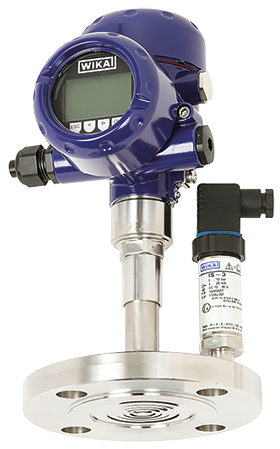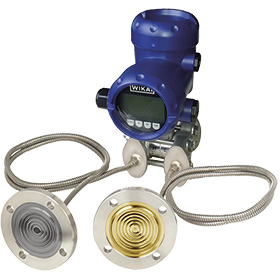
Pressure measurement plays a central role in chlorine production, which is a safety-critical process. This is due to the fact that chlorine is highly reactive, and can therefore easily trigger explosions in combination with organic substances. So it is important to monitor all production steps precisely in order to avoid damage to people and the environment. This is why diaphragm seal systems make all the difference when it comes to measuring process pressure. These welded units of diaphragm seal and measuring instrument provide both the durability and the accuracy required.

For this reason, the European manufacturers’ association, Euro Chlor, recommends implementing a process connection via diaphragm seals for pressure measurement in chlorine production. When designing a diaphragm seal, users must ensure that all wetted parts are made of chlorine-resistant materials. Tantalum, Hastelloy C276 and titanium, but also plastics such as ECTFE, are possible materials, depending on the application. The system fill fluid must also be inert to reaction with most substances, which applies to halocarbon oil, for example.
Chlorine is produced from sodium chloride and water via chlor-alkali electrolysis. Two co-products are generated in the process: hydrogen and caustic soda. Successful electrolysis therefore requires the separation of anode and cathode, so that chlorine and hydrogen do not combine to form an explosive mixture. That is why the industry mostly uses the energy-saving diaphragm process for electrolysis. This requires a special, extremely thin diaphragm to be placed between the anode and the cathode, allowing only positive sodium ions to diffuse.
The requirements for pressure measurement in electrolysis-based chlorine production are complex. Simply installing pressure transmitters on the two chambers of the plant is not enough. It is crucial to determine the differential pressure between the chambers. This is because the sensitive diaphragm will remain intact only if the pressure conditions are balanced. Consequently, changes in differential pressure must be detected immediately so that the process can be stopped promptly in the event of a fault.
Highly accurate differential pressure transmitters with two diaphragm seals are tailored to this task, for example the WIKA model DPT-20, featuring an accuracy of 0,1% of span. Considering the critical environment, the instrument should have an approval for hazardous area. Depending on the measuring task, the diaphragm seals of the differential pressure transmitter are designed differently: chlorine measuring locations must have a tantalum diaphragm, while hydrogen measuring locations require a diaphragm with gold plating.
Electrolysis is by no means the only process step in chlorine production that requires highly reliable pressure measurement. In some processes, however, damage to the diaphragm seal can never be fully ruled out. Though diaphragm seals are manufactured in accordance with the process conditions, they may be damaged due to unexpected overpressure or corrosion of adhering particles. Unwanted deformation can seriously distort the measurement result. Moreover, diaphragm rupture would cause the system fill fluid to enter the process and impair the chlorine quality.

The model DMS27 diaphragm seal system, with built-in diaphragm monitoring, reliably continues pressure monitoring, even in the event of a diaphragm rupture. The process remains closed until the damage is repaired.
This kind of damage at particularly critical points in the process can be prevented by using a diaphragm seal system with built-in diaphragm monitoring. In this system developed by WIKA – specifically the model DMS27 in the case of chlorine applications – the diaphragm seal features two diaphragms on top of each other. The space between them is evacuated and the resulting vacuum monitored by a sensor. If the process-side diaphragm is damaged, the second diaphragm takes over. Since the vacuum loss is simultaneously recorded, an electronic alarm signal will be transmitted when the critical value is reached. The process pressure continues to be monitored reliably until a replacement is installed. In addition, there is no risk of contamination by leaking fill fluid.
| Tel: | +27 11 621 0000 |
| Email: | [email protected] |
| www: | www.wika.co.za |
| Articles: | More information and articles about WIKA Instruments |
© Technews Publishing (Pty) Ltd | All Rights Reserved